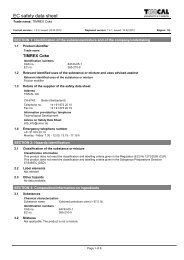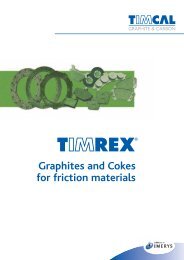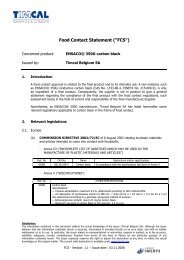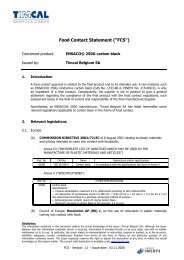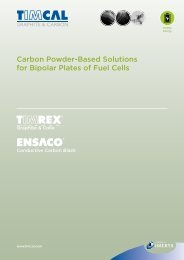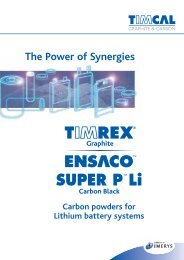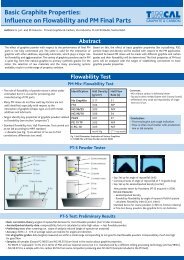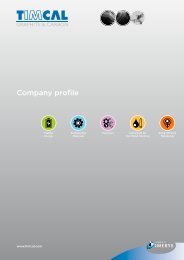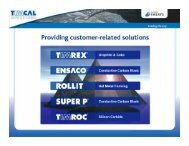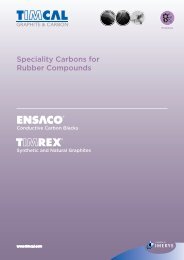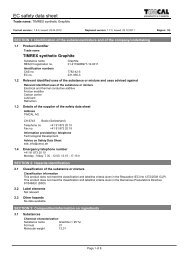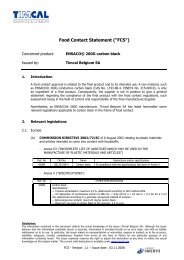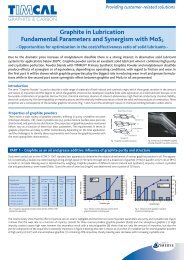ENSACO® Conductive Carbon Black for polymer ... - Timcal Graphite
ENSACO® Conductive Carbon Black for polymer ... - Timcal Graphite
ENSACO® Conductive Carbon Black for polymer ... - Timcal Graphite
You also want an ePaper? Increase the reach of your titles
YUMPU automatically turns print PDFs into web optimized ePapers that Google loves.
14<br />
Rubber<br />
<strong>Carbon</strong> black is one of the main ingredients<br />
of any rubber compound. <strong>Conductive</strong> carbon<br />
blacks are be<strong>for</strong>e all carbon blacks, to be mixed<br />
and handled as any other rein<strong>for</strong>cing or semirein<strong>for</strong>cing<br />
carbon black. They are high structure<br />
materials bulky by nature. Although the<br />
common carbon blacks are conductive by<br />
nature and impart also conductivity to the<br />
compounds when used in sufficiently high<br />
loading, conductive carbon blacks have the<br />
advantage to reach conductivities at lower loading<br />
and are often used to give the final boost to<br />
a compound already filled with other carbon<br />
blacks. As carbon black structure is the parameter<br />
determining the conductivity, structure<br />
being an additive property, the combinations of<br />
conductive and normal black can be predicted.<br />
Specifications of rubber compounds being<br />
usually quite complex and conductivity being<br />
only one of the numerous physical requirements,<br />
the use of carbon black blends is very<br />
often the only solution.<br />
In some specific cases, especially in special<br />
<strong>polymer</strong>s, it occurs that the conductive carbon<br />
black is used by its own in order to maintain<br />
mechanical properties and processing at a good<br />
level.<br />
ENSACO ® carbon blacks are, as mentioned<br />
above, quite close to furnace blacks as far as the<br />
rein<strong>for</strong>cing activity is concerned. Especially the<br />
low surface area carbon blacks, grades 150, 250<br />
and 260, are, due to their very easy dispersion,<br />
quite per<strong>for</strong>ming in most rubber compounds.<br />
ENSACO ® 350 is also used in some compounds<br />
where small additions are required.<br />
www.timcal.com<br />
Typical applications <strong>for</strong> ENSACO ® <strong>Conductive</strong> <strong>Carbon</strong> <strong>Black</strong><br />
A few conductive<br />
applications:<br />
belt cover compounds;<br />
flooring;<br />
conveyer belts;<br />
hoses <strong>for</strong> fuel, <strong>for</strong> conveying<br />
of powders, etc.;<br />
cylinder coating;<br />
shoe soles;<br />
seals.<br />
ENSACO ® 150 and 250 are also used in non<br />
conducting applications where the compounder<br />
can take profit of the low surface area and high<br />
structure of those blacks:<br />
low hysteresis with relatively high hardness;<br />
good thermal aging;<br />
very good tear strength;<br />
very good dispersion, very good mechanical<br />
per<strong>for</strong>mance at thin layer.<br />
A few non-conductive<br />
applications:<br />
antivibration systems;<br />
textile coating;<br />
membranes;<br />
articles exposed to chipping and chunking.<br />
In the following pages there are some of the<br />
results of experimental work carried out on<br />
ENSACO ® <strong>Conductive</strong> <strong>Carbon</strong> <strong>Black</strong>s in different<br />
rubber compounds.<br />
The data shown here are given as orientation<br />
and are valid <strong>for</strong> the particular <strong>for</strong>mulations<br />
and sample preparation technique<br />
mentioned. Results in other <strong>polymer</strong>s, full<br />
studies and publications are available upon<br />
request.



